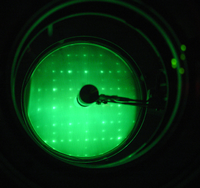Low-energy electron diffraction

Low-energy electron diffraction (LEED) is like shining a flashlight on a wall and seeing the light bounce off in different directions. But instead of a flashlight and a wall, we use electrons and a crystal.
When we want to study the atoms on the surface of a crystal, we need to use a special technique that allows us to see the arrangement of atoms. That's where LEED comes in.
We shoot a low-energy beam of electrons at the surface of the crystal. These electrons are kind of like tiny particles that move really fast. When they hit the surface of the crystal, they bounce off in different directions, just like the light from our flashlight.
But instead of bouncing off randomly, the electrons bounce off in a pattern that tells us about the arrangement of the atoms on the crystal's surface. This pattern is called a diffraction pattern.
It's a bit like when you drop a pebble in a pond and you see ripples spreading out in a circular pattern. The ripples give you information about what's underneath the surface of the water.
Similarly, the diffraction pattern formed by the electrons bouncing off the crystal's surface gives us information about the arrangement of the atoms on the surface. We can use this information to study the crystal's properties and behaviour.
So low-energy electron diffraction is kind of like shining a special beam of electrons on a crystal to get a picture of its atoms.
When we want to study the atoms on the surface of a crystal, we need to use a special technique that allows us to see the arrangement of atoms. That's where LEED comes in.
We shoot a low-energy beam of electrons at the surface of the crystal. These electrons are kind of like tiny particles that move really fast. When they hit the surface of the crystal, they bounce off in different directions, just like the light from our flashlight.
But instead of bouncing off randomly, the electrons bounce off in a pattern that tells us about the arrangement of the atoms on the crystal's surface. This pattern is called a diffraction pattern.
It's a bit like when you drop a pebble in a pond and you see ripples spreading out in a circular pattern. The ripples give you information about what's underneath the surface of the water.
Similarly, the diffraction pattern formed by the electrons bouncing off the crystal's surface gives us information about the arrangement of the atoms on the surface. We can use this information to study the crystal's properties and behaviour.
So low-energy electron diffraction is kind of like shining a special beam of electrons on a crystal to get a picture of its atoms.
